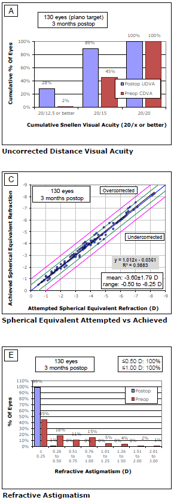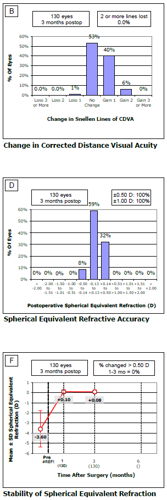Cataract, Refractive
Striving for Perfection in LASIK
Combining topography and astigmatism data helps achieve 20/15 in most eyes.

Howard Larkin
Published: Tuesday, August 29, 2023
 For years, Dr Mark Lobanoff eagerly awaited topography-guided LASIK to make its way from Europe to the United States. Reproducibility and independence from pupil size are among the advantages over earlier wavefront-guided ablation approaches.
For years, Dr Mark Lobanoff eagerly awaited topography-guided LASIK to make its way from Europe to the United States. Reproducibility and independence from pupil size are among the advantages over earlier wavefront-guided ablation approaches.
But when Alcon’s Contoura Vision topography-guided LASIK finally arrived, his results were not as good as expected. While 88% of eyes in the FDA approval trial reached 20/20 or better uncorrected and 59% reached 20/15 or better, Dr Lobanoff’s early cases saw 73% and 26%, respectively. Similarly, Dr A John Kanellopoulos reported 61% and 22%, respectively.
Behind the discrepancy was the manufacturer’s recommendation to base topographic corrections on manifest refractions, Dr Lobanoff said. While this worked well in the near-perfect corneas allowed into the FDA trial, it didn’t work as well on real-world corneas with significant higher- order aberrations. Topographically correcting corneas with less than 4 microns of corneal astigmatism does not significantly change the cornea’s refractive power, whereas removing 24 microns does, he explained.
What’s needed is an approach that addresses the reasons why a patient’s manifest and measured anterior corneal astigmatism differ. So, ever striving for LASIK perfection, Dr Lobanoff developed the Phorcides Analytic Engine.
Multiple factors
A decision support software package available for free to any surgeon, Phorcides calculates a topographic ablation solution based on multiple factors. It predicts the effects of combining topographic treatment with anterior corneal cylinder power. The software also considers significant contributions from posterior corneal and lenticular astigmatism. Dr Lobanoff measures the posterior cornea with Scheimpflug imaging.
 Developing it required expertise in topographic analysis, leading Dr Lobanoff to contact geographic imaging software producers as potential partners.
Developing it required expertise in topographic analysis, leading Dr Lobanoff to contact geographic imaging software producers as potential partners.
“I approached 10 companies, and 9 of the 10 said I was crazy and didn’t want to talk to me. One company said I was crazy, but they would talk to me.”
Getting the right skill set was critical, Dr Lobanoff added. “I finally found a programmer with a background in physics, so he could understand the optical physics we were talking about and the software programming. It took me a while, but once we found that correct individual, we really could make progress and take off.”
The resulting software generates a topographic ablation solution in about 10 seconds, with excellent results.
In a study involving 130 eyes treated for myopia in four centres, 100% achieved 20/20 or better uncorrected, 89% 20/15 or better, and 28% 20/12.5 or better. Mean correction was -3.60 ± 1.79 D, ranging from -0.5 to -8.25 D, and 99% had 0.25 D or less residual cylinder.1
Similarly, a Phorcides topo-guided LASIK study by Dr Sloan W Rush saw 58.7% of 92 eyes in 46 patients reached 20/12.5 uncorrected, 98.9% 20/20 monocularly, and 100% 20/16 or better binocularly.2
“Really, some spectacular results,” Dr Lobanoff concluded.
Dr Lobanoff presented at the Innovators Session of the 2023 ASCRS annual meeting in San Diego, US.
For citation notes, see page 54.
Mark Lobanoff MD is founder and president of OVO LASIK + LENS, a private clinic; founder and CEO of Phorcides, a LASIK software firm; and CEO of American Corneal Consultants, a research organisation, all based in Minneapolis, Minnesota, US. mlobanoff@gmail.com